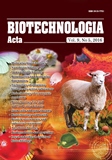"Biotechnologia Acta" V. 9, No 5, 2016
https://doi.org/10.15407/biotech9.05.038
Р. 38-44, Bibliography 12, English
Universal Decimal Classification: 664.15

TWO- PRODUCT ALCOHOL OBTAINING TECHNOLOGY BASED ON CONTINUOUS GRADIENT YEAST GENERATING
V. Levandovskyi, V. S. Myhhailyk
Kyiv national university of trade and economics, Ukraine
The work objective was to use a serial connection of yeast generators (according to the battery principle) and by means of this to increase the rate of medium dilution therein from 0.18–0.20 to 0.88–0.96 h-1, to reduce the solids concentration in the yeast mash from 17 to 10–12% and to enter the whole volume of it into the first streamwise device. The amount of molasses that has not been added to the mash in order to solids concentration reduction in it was introduced into the last two yeast generators. Consequently, it has been clearly shown the intensification of biomass accumulation, its yield increase by 29% with regard to ethanol amount and increase in productivity of yeast culturing by 18%.
Key words: yeast, yeast generator, fermentation.
© Palladin Institute of Biochemistry of the National Academy of Sciences of Ukraine, 2016
References
1. Shiyan P. L., Sosnytskiy V. V., Oliynichuk S. T. Innovative technologies of alcohol industry. Theory and practice. Kyiv: Аskaniya. 2009, 424 p. (In Ukrainian).
2. Marynchenko V. A., Domaretskyy V. A., Shiyan P. L. Technology of alcohol. Vinnitsa: Podole-2000. 2003, 496 p. (In Ukrainian).
3. Typical technological regulation of production molasses-alcoholic mash and pressed baking yeast: TR Ukr 18.8049-2004. Kyiv: UkrNDIspyrtbioprod: Ministry of Agrarian Policy of Ukraine. 2004, 62 p. (In Ukrainian).
4. Polygalinа G. V. Technochemical control of alcohol and distillery production. Мoskwа: Kolos. 1999, 336 p. (In Russian).
5. Ghorbani F., Younesi H. The kinetics of ethanol production from cane molasses by saccharomyces cerevisiae in a batch bioreactor. Energy Sources, Part A: Recovery, Util.Environm. Effects. 2013, 35 (11), 1073–1083.
6. Bouallagui H., Touhami Y., Hanafi N., Gharani A., Hamdi M. Performances comparison between three technologies for continuous ethanol production from molasses. Biomass Bioen. 2013, V. 8, P. 25–32.
7. De Andrade R., C?ndida Rabelo S., Maugeri Filho F., Maciel Filho R., Carvalho da Costa A. Evaluation of the alcoholic fermentation kinetics of enzymatic hydrolysates from sugarcane bagasse (Saccharum officinarum L.). J. Chem. Technol. Biotechnol. 2013, 88 (6), 1049–1057.
8. Levandovsky L. V., Nichik O. V., Yakovenko A. A. Influence of cultivation duration of alcohol yeast on the results of fermentation of molasses wort. Production of alcohol and alcoholic beverages. 2012, N 2, P. 13–15. (In Russian).
9. Levandovsky L. V., Nichik O. V., Semenyuk Yu. V. Influence of the composition of molasses wort on the effectiveness of two-product of alcohol production and baker's yeast. Production of alcohol and alcoholic beverages. 2012, N 1, P. 11–13. (In Russian).
10. Fakruddin M., Quayum M., Ahmed M., Choudhury N. Analysis of key factors affecting ethanol production by Saccharomyces cerevisiae IFST-072011. Biotechnology. 2012, 11 (4), 248–252.
11. Pe?a C., Arango R. Evaluation of ethanol production using recombinant strains of Saccharomyces cerevisiae from sugar cane molasses. DYNA. 2009, V. 159, P. 153–161.
12. Herrera W. E., Filho R. M. Development of a monitoring hybrid system for bioethanol production. Chem. Engin. Transact. 2013, V. 32, P. 943–948.

